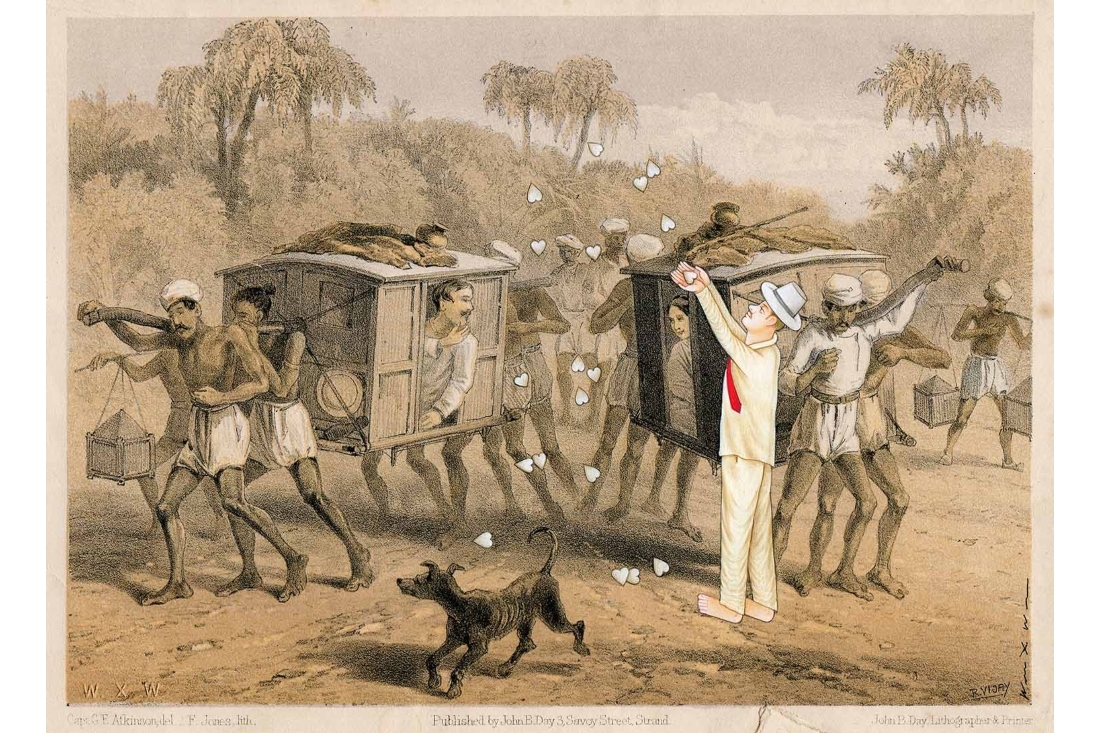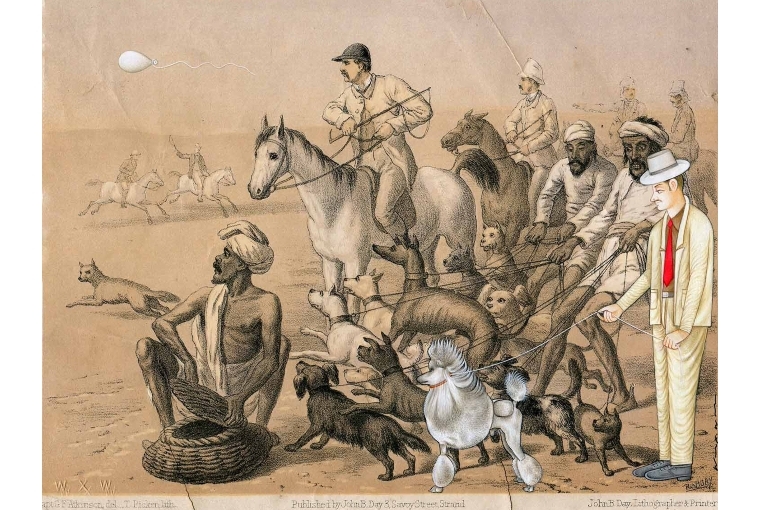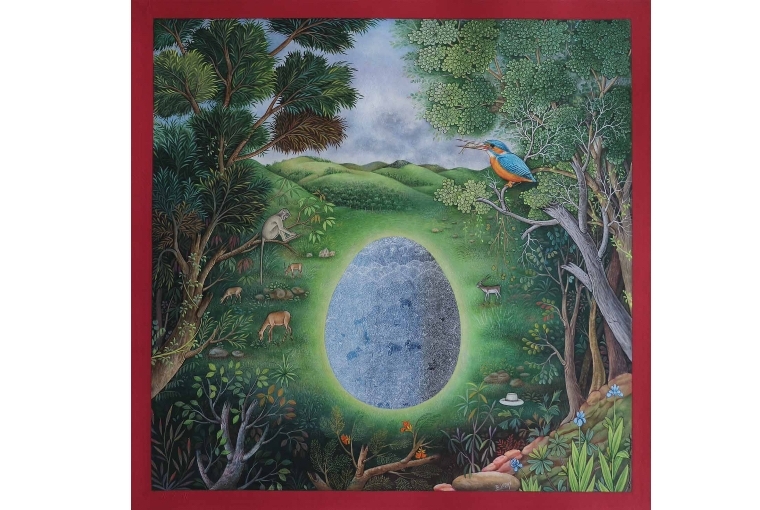
Art: Waswo X Waswo & R. Vijay

Art: Waswo X Waswo & R. Vijay
For his upcoming series of miniature paintings, eminent artist and photographer, Waswo X. Waswo has collaborated with his long-time artistic partner, R. Vijay. Serving as their muse and spring-board, is a satirical 19th-century novel called Curry & Rice by British army captain and artist George F Atkinson. Waswo revisits the sepia-toned lithographs of the book with his fedora-topped alter ego in tow. By inserting this familiar and decidedly 21st-century figure into genteel scenes from a Raj-era cantonment town, Waswo either underlines the author’s original perspective or subverts it altogether.
We connected with him to know more about the project, his artistic journey, and the role of art in the current pandemic and beyond.
When did your romance with art begin?
'Romance' is probably a good choice of words, as it implies both love and also inevitable, (if finally fulfilling) conflicts. My mother and father were both artists, but my mother was much more talented than my dad. Art ran in the family, with a cousin teaching art in the public schools, and her husband, the Art Director of the local natural history museum. However, initially I veered more toward writing and literature, and that is what I actually studied in college. I discovered later that I enjoyed making wildly colorful abstract paintings, something my mother abhorred since she was extremely traditionalist in her approach. So I learned early on that 'art is an argument', a phrase I often repeat. An artist needs to defend what he does, and it is perhaps here where my training in writing comes to my aid. Art has been the love/hate affair of my life, and it often fills me with as much pain as enjoyment and solace. So yes, it is a romance, and a very passionate one. If you are not passionate about your art, I fail to see how you can be an artist.
What inspires you as an artist?
At one point I fell in love with photography, abandoning the abstract art that had once enthralled me. In ways, photography brought me back to reality after a long period of trying to escape it. I enrolled in The Milwaukee Center for Photography, and later went on to study photography in Italy. I don't want to repeat the by now the well-known story of how India changed my photographic practice from the street to the studio, but what inspires me in both my photography and the miniature paintings that I make in collaboration with R. Vijay, comes down to three things: an appreciation of beauty as created through fine craftsmanship, a respect for common people and their alternative histories, and the unfolding of my own personal narrative as an 'outsider' in India.
Could you tell us a little bit about your latest miniature art project and your creative process behind it.
I'm working with no less than four artists now: Rajesh Soni, the photo hand-colourist, R. Vijay, the miniaturist painter, and Dalpat Singh, an assistant to R. Vijay, who has been with us for about four years now. Then there is Shankar Kumawat, our longtime border painter who we've worked with for nearly thirteen years. So, our projects often develop concurrently within what we call the karkana, which of course means 'factory', but has an older etymology meaning of a miniature painting workshop. Currently I've been working with Shankar to develop his border work into some stand-alone pieces, and this project is yielding some really nice results. Dalpat and R. Vijay have just completed a very large painting from our ongoing series Pages from a Burning Storybook, and R. Vijay and I have been pursuing our newest series, which we call The Intruder, which is a painted intervention upon vintage Curry and Rice lithographs by George Franklin Atkinson. This last series is probably the most fun. I find a certain affinity with Atkinson and his tongue-in-cheek depictions of the mythical village of Kabob. Our own figure of the 'fedora man' enters these lithographs to subvert them, mock them, or, harmonize with them. I think this is one of our most unique and challenging series to date.

The Intruder
What do you think the role of art and an artist is in our current situation?
That's a hard question for me, as I adhere to the notion that art is a very personal endeavour and a personal expression, and believe that art ought to focus more on recurring human experiences and emotions than current events. However, obviously we cannot ignore such a cataclysmic situation. We were asked by our gallery, Gallery Espace, to respond to the current scenario via two works which they hope to include in an upcoming portfolio. Both works concentrate on the isolation and loneliness of the protagonist, in juxtaposition with nature. The natural world, and an ecological world view has always infused our miniatures. In these new works, the fedora man can be found isolated from nature and wearing the now ubiquitous symbol of the face mask. I deliberated a lot on the idea of the mask entering our work, as I normally eschew too obvious contemporary references. However, in the end I realized there was no way around it. Covid-19 has entered our collective consciousness now. It, or at least the idea of the retaliation of the natural world, needed to enter our often idyllic landscapes. We've dealt with concepts of pollution and even deforestation and global-warming before, but this is the first time we needed to insert reference to a plague.
How do you think the world of art will change or should change post the pandemic?
It's impossible to predict that. Right now everything has gone online, from Zoom symposiums to virtual exhibitions. I think the sudden embrace of technologies such as Zoom will continue long after this is over, as the art world has discovered its usefulness, but I am sure we will one day return to the traditional exhibition and vernissage, as collectors still like to mingle with gallerists, curators and artists in real life. I'm afraid we'll lose many smaller galleries simply due to their inability to sustain themselves through a long period of lockdown. I could hope that the art world might change in all sorts of other, more idealistic ways, but I doubt it. If people are anything, they are quite dependably creatures of habit.

Rebirth in Absence
Everyone has different ways of coping with the isolation, what has/ have been yours?
For my collaborators, lockdown was not a huge problem, as most worked from their homes anyway. I've kept them all busy and pay them as normal. They have families, and are hardly alone. For me the loneliness becomes almost unbearable at times, but I think the best way to combat that is via work. I've been maintaining a small YouTube channel called Evil O for over a year now. In lockdown, I discovered that this channel could be used to help bring people together in a way they could no longer do in physical space. The channel gained a large number of subscribers once it began the series Coronavirus Artpocalypse, and the newer series Dialogues, where I talk one-on-one with an artist or a person connected with the art scene. Just the interviews and video editing keeps me quite busy, plus now I've begun work on a new book. This new book will take a deep dive into the history and workings of our karkhana.
What will be the new normal for you post the pandemic?
I will step outside, and never again take that simple freedom for granted.
Text Nidhi Verma
Art Waswo X Waswo & R. Vijay

Photography: Meropie Mitrou